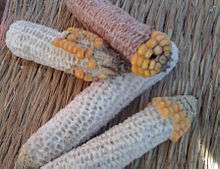Corncob


A corncob, also spelled corn cob, is the central core of an ear of maize (Zea mays ssp. mays). It is the part of the ear on which the kernels grow. The ear is also considered a "cob" or "pole" but it is not fully a "pole" until the ear is shucked, or removed from the plant material around the ear.
Young ears, also called baby corn, can be consumed raw, but as the plant matures the cob becomes tougher until only the kernels are edible.
When harvesting corn, the corncob may be collected as part of the ear (necessary for corn on the cob), or instead may be left as part of the corn stover in the field.
The innermost part of the cob is white and has a consistency similar to foam plastic.
Uses
Corncobs find use in the following applications:
- Industrial source of the chemical furfural[1]
- Fiber in fodder for ruminant livestock (despite low nutritional value)
- Water in which corncobs have been boiled contains thickeners and can be added to soup stock or made into traditional sweetened corncob jelly
- Bedding for animals – cobs absorb moisture and provide a compliant surface[2]
- A mild abrasive for cleaning building surfaces, when coarsely ground
- Raw material for bowls of corncob pipes[3]
- As a biofuel[4]
- Charcoal production
- Board making
-

A corncob pipe
References
- ↑ Engineers, N.B.C. (2006). Wheat, Rice, Corn, Oat, Barley and Sorghum Processing Handbook (Cereal Food Technology). Asia Pacific Business Press. p. 173. ISBN 978-81-7833-002-0.
- ↑ Aston, Andrew (November 14, 2010). "Bedding For Laboratory Animals". ALN Magazine. Retrieved October 28, 2015.
- ↑ Tobacco Leaf. 1907. p. 36, 38. Retrieved October 29, 2015.
- ↑ Roth, Greg; Gustafson, Cole (January 31, 2014). "Corn Cobs for Biofuel Production". Cooperative Extension System. Retrieved October 28, 2015.
